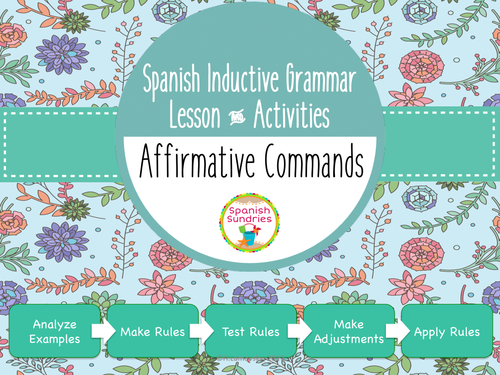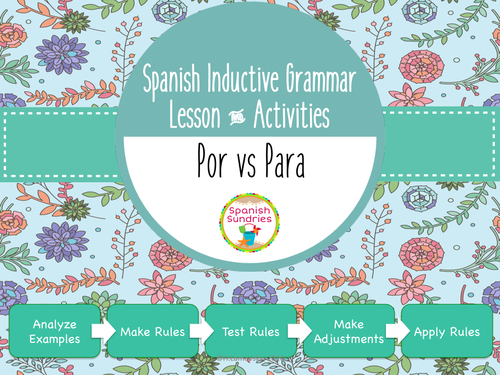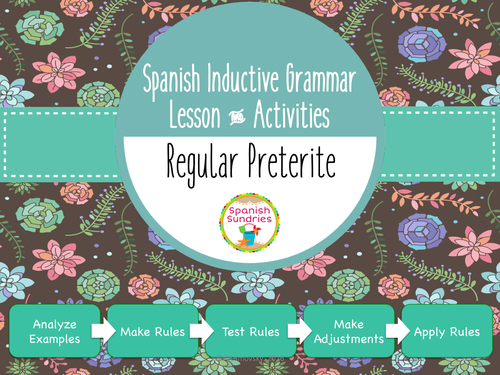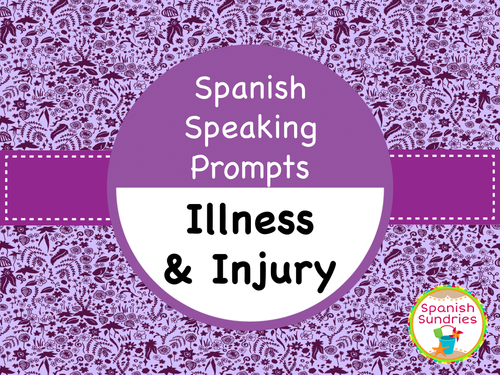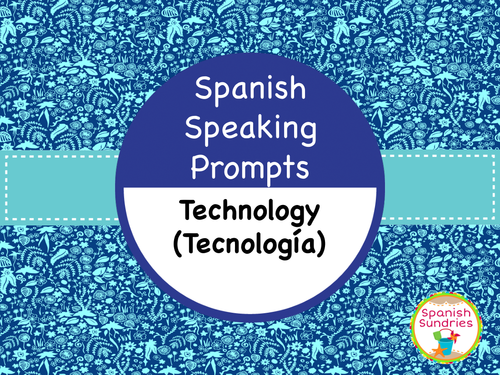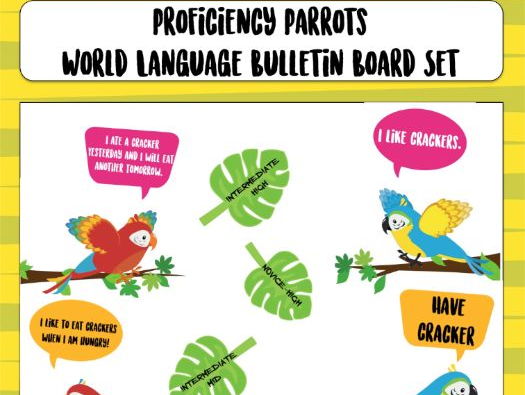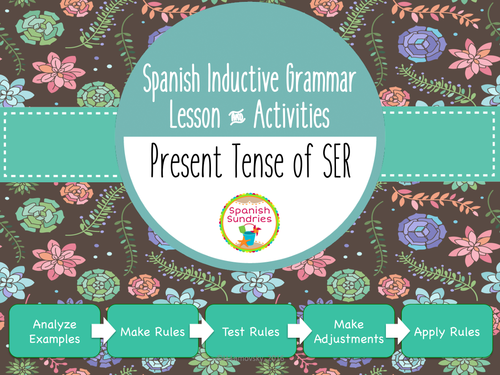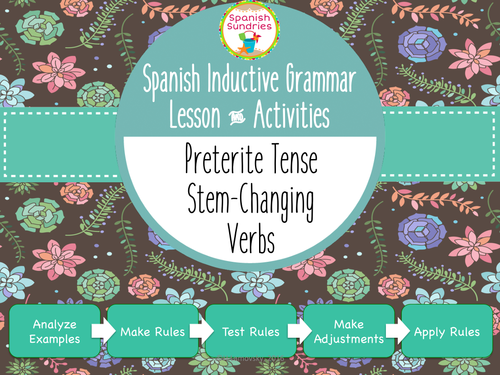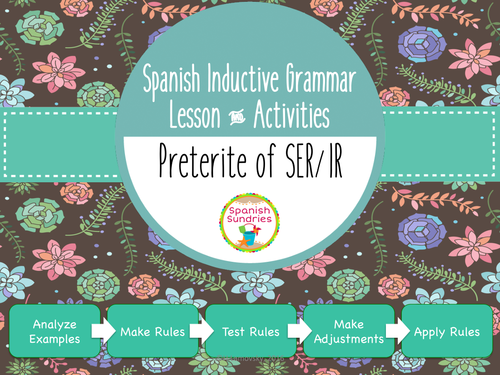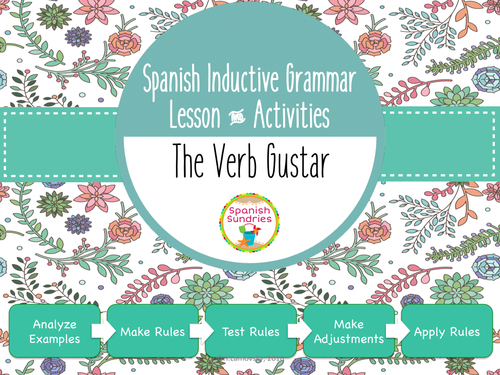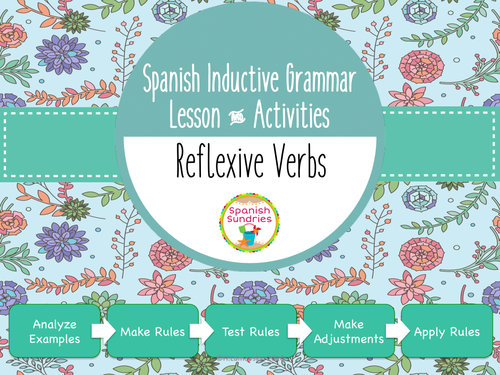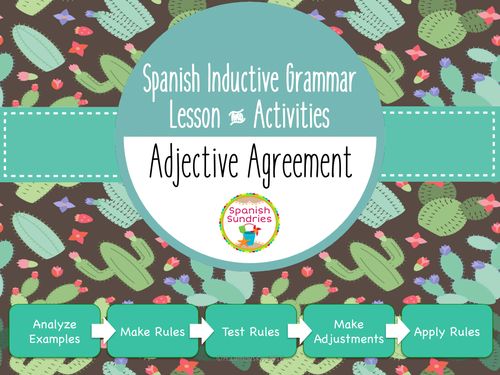
320Uploads
93k+Views
4k+Downloads
World languages

Spanish Inductive Grammar Lesson: Affirmative Commands
This inductive grammar lesson leads students to discover the rules behind using both informal and formal affirmative commands in a variety of situations in Spanish.
Students will follow a 4 step inductive process to make learning grammar more meaningful.
Step 1: Students will see examples of correct usage and create rules based on what they observe.
Step 2: Students will test those rules against additional examples of correct language usage.
Step 3: Students will make adjustments and additions to their rules based on more observations. They will summarize what they have discovered by creating their own graphic organizer using the included template.
Step 4: Students will apply the rules while producing their own language.
These scaffolded activities promote higher order thinking skills and represent the method of grammar instruction that is recommended by national organizations like ACTFL.

GIANT Spanish Culturopoly Board Game
The second of our GIANT Board Games, Culturopoly focuses on teaching students about the important people, products, and places of the countries of Mexico, Spain, Guatemala, Puerto Rico, Ecuador, Panama, Costa Rica, Cuba, Peru, Chile, Argentina, and Venezuela. This is a great whole-class game that transforms the floor of your classroom into a giant board game.
With a style of game play similar to Monopoly, students travel around the game board collecting cultural facts about the various countries. Once they gather enough facts, if they land on a "maleta" space, they can answer some trivia questions about a particular country in order to earn a "boleto de ida y vuelta". The team with the most "boletos" at the end end of the game wins.
The best part of this game is that it is easily adaptable to any age group and proficiency level. With three different difficulty levels (Easy, Medium, Hard), it is perfect for an exploratory or Latin American Studies class all the way through an upper level Spanish class. While the Easy mode allows for students with no knowledge of Spanish, the Medium mode starts to introduce target language terms for students with minimal Spanish language proficiency, and the Hard mode focuses on play completely in the target language.
This is a great way to review for culture portions of midterm or final exams, or for any day that you just need something different. In the future, there will be expansion packs to add different Spanish-speaking countries to the game. Either way, any teacher will get a LOT of use out of this one game.
This Resource Includes:
-Complete Set-up and Game Play Instructions for each mode
-Fifty 8 1/2 x 11 Game Spaces with pictures representative of cultural items
-12 Boletos de Ida y Vuelta (one per country)
-12 Easy Difficulty Country Challenge Cards w/ answer keys
-12 Medium Difficulty Country Challenge Cards w/ answer keys
-12 Hard Difficulty Country Challenge Cards w/ answer keys
-36 Culture Fact Cards

Introductions Spanish Listening Activities
These activities were created to assist Novice language learners in developing skills related to ACTFL modes of communication, with an emphasis on the mode of interpretive listening in the context of Spanish greetings and introductions.
The activities that accompany the audio recordings were created to allow teachers to easily differentiate and target specific skills.
“E” Activities – these activities are presented in English and focus on students being able to demonstrate comprehension of the audio sample.
“S” Activities – these activities are presented in Spanish and ask students to respond in Spanish. They will allow students to improve presentational writing and/or speaking skills (if done orally) as well as aural recognition of vocabulary.
“A” Activities – these activities focus on using context to predict word meanings and general vocabulary knowledge.
“B” Activities – these activities focus on making inferences about the person or situation presented in the audio samples.
“C” Activities – these activities, presented in English, assist students in making cultural connections to the information presented in the audio sample.
This resource deals with the theme of introductions in Spanish and includes:
-2 audio samples
sample 1: A man introduces himself and gives basic personal information
sample 2: A man introduces his sister and tells a bit about her.
7 Activities in two different formats
Half Page Format – works well if you are using the activities as bell ringers, exit tickets, to differentiate, or for quick formative assessments.
Continuous Page Format – works well if you will be having students complete all of the activities for a given sample.

Spanish Inductive Grammar Lesson - Por vs Para
This inductive grammar lesson leads students to discover the rules behind using the words POR and PARA in a variety of situations in Spanish.
Students will follow a 4 step inductive process to make learning grammar more meaningful.
Step 1: Students will see examples of correct usage and create rules based on what they observe.
Step 2: Students will test those rules against additional examples of correct language usage.
Step 3: Students will make adjustments and additions to their rules based on more observations. They will summarize what they have discovered by creating their own graphic organizer using the included template.
Step 4: Students will apply the rules while producing their own language.
These scaffolded activities promote higher order thinking skills and represent the method of grammar instruction that is recommended by national organizations like ACTFL.

Spanish Inductive Grammar Lesson - Regular Preterite Tense
This inductive grammar lesson leads students to discover the rules behind using regular verbs in the preterite tense in Spanish.
Students will follow a 4 step inductive process to make learning grammar more meaningful.
Step 1: Students will see examples of correct usage and create rules based on what they observe.
Step 2: Students will test those rules against additional examples of correct language usage.
Step 3: Students will make adjustments and additions to their rules based on more observations.
Step 4: Students will apply the rules while producing their own language.
These scaffolded activities promote higher order thinking skills and represent the method of grammar instruction that is recommended by national organizations like ACTFL.

Spanish Speaking Prompts - Enfermedades y Salud
These speaking prompts are designed to move students from asking/answering basic questions in Spanish to responding to increasingly complicated prompts around the theme of Illness & Injury (Enfermedades).
There are 4 categories of prompts that ask students to move between different levels of communication including the presentation of facts, opinions, feelings, and towards complete openness in social situations.
Category A – Yes or No Questions, Either/Or Questions
Category B – Additional Information Questions
Category C – Expressing Opinions and Feelings
Category D – Situational Speaking Prompts & Extended Response
You may approach these prompts by moving students through them from Categories A-D in a sequential manner, or you may use them as an opportunity for easy differentiation between the various proficiency levels of Novice to Intermediate learners that may be present in your classroom.
Although these prompts have been designed as speaking prompts, they can also be used as writing prompts for individual practice, homework, or assessment.
Ideas for Usage:
-Pair students for one on one practice.
-Form small groups and have students interview a student.
-Invite a guest speaker or native speaking student to your classroom and have students select questions to ask them during a Q&A session
-Have students write additional prompts or variations of existing prompts on the blank cards provided
-Pull 1 prompt from each category for a challenging oral proficiency assessment
-Have students develop role plays based on the situational prompts
This Product Includes
-Guide for Educators
-15 Category A Prompts
-15 Category B Prompts
-9 Category C Prompts
-6 Category D Prompts
-Blank Cards to allow for creation of additional questions if desired

Spanish Speaking Prompts - Tecnología
These speaking prompts are designed to move students from asking/answering basic questions in Spanish to responding to increasingly complicated prompts around the theme of Technology.
There are 4 categories of prompts that ask students to move between different levels of communication including the presentation of facts, opinions, feelings, and towards complete openness in social situations.
Category A – Yes or No Questions, Either/Or Questions
Category B – Additional Information Questions
Category C – Expressing Opinions and Feelings
Category D – Situational Speaking Prompts & Extended Response
You may approach these prompts by moving students through them from Categories A-D in a sequential manner, or you may use them as an opportunity for easy differentiation between the various proficiency levels of Novice to Intermediate learners that may be present in your classroom.
Although these prompts have been designed as speaking prompts, they can also be used as writing prompts for individual practice, homework, or assessment.
Ideas for Usage:
-Pair students for one on one practice.
-Form small groups and have students interview a student.
-Invite a guest speaker or native speaking student to your classroom and have students select questions to ask them during a Q&A session
-Have students write additional prompts or variations of existing prompts on the blank cards provided
-Pull 1 prompt from each category for a challenging oral proficiency assessment
-Have students develop role plays based on the situational prompts
This Product Includes
-Guide for Educators
-15 Category A Prompts
-15 Category B Prompts
-9 Category C Prompts
-6 Category D Prompts
-Blank Cards to allow for creation of additional questions if desired

Spanish Writing Prompts
This EDITABLE resource contains 30 writing prompts on topics common to beginning Spanish (level 1 & 2). Prompts are duplicated 2 per page for efficient copying and include the prompt, a word box with useful vocabulary, and writing space.
An interactive table of contents is included to make finding the right prompt for your lesson quick and easy.
These prompts can be used as bell ringers, entrance/exit tickets, or classroom activities. They also can easily be added to interactive notebooks.
Best of all, they are completely EDITABLE so you can adjust the vocabulary to suit your students and use the formatting to add additional prompts as you go.
For a detailed list of each prompt, please see the thumbnail image above.

Spanish Sub Plans: Festivals of Spain
These Spanish sub plans can be carried out by any sub while you are out of the classroom. Even better, you won't have to feel guilty that your students aren't learning while you are gone!
This set includes 5 full classes of lessons based on various festivals that take place in Spain. Each on is ready to print & go, requires no technology, do not require the sub to produce any Spanish, and can be differentiated for any level of Spanish class.
Each lesson walks students through important and interesting information related to a different Spanish festival and asks them to use higher-order thinking skills, problem solving, and critical thinking skills to understand the culture behind that tradition.
Spanish Festivals in these lessons include:
-La Tomatina (Buñol)
-Las Fallas (Valencia)
-Semana Grande (Bilbao)
-Cristianos y Moros
-Bizarre Spanish Festivals
Students will work step by step to learn about each celebration through a series of activities that ask them to use what they have learned and apply it to the present day, make cultural inferences about the purpose and origin of these traditions, and compare these events to events in their own culture and others. Each lesson asks students to think about the festival in the larger cultural context as they make observations and consider some thought provoking questions.
These lessons are fully aligned with the ACTFL cultural competencies for world language learners and also can be used to address several of the culture themes found on the AP Spanish test.

Cortometraje Activities: Selfie Cat
These listening, reading, writing, and speaking activities accompany the cortometraje "Selfie Cat". Similar to MovieTalk, these lessons focus not only on speaking, but on all communicative skills.
Students are introduced to 8 key vocabulary words that will help them to talk about the story in Spanish.
Prior to watching the animated short, they will consider a couple of questions which can then be discussed with a partner, as a whole class, or reflected on with a written response.
After watching the cortometraje, students will engage in listening activities where they must match scenes of the short with description in Spanish, reading activities where they must apply new vocabulary, writing activities where they must describe scenes, and speaking activities where they must retell the events of the story.
These are great anytime activities with a lot of comprehensible input that seek to develop all modes of communication.
This resource includes:
-Link to the Cortometraje
-Key Vocabulary
-Discussion Activity
-Listening Activity
-Listening Script for Teacher
-Reading Activity
-Writing Activity
-Speaking Activity
-Answer Keys for all Objective Activities

World Language Proficiency Parrots
This colorful bulletin board set will help your students understand the different language proficiency levels from Novice-Low to Intermediate-High.
In addition to the visuals needed to create the bulletin board, there are ideas for how to incorporate the bulletin board and proficiency levels into classroom activities from the very first day of school.
Best of all, if the visuals get worn out, you will always have access to this file to print new ones for years to come. You will also have access to updates and/or additions to this resource.
This Bulletin Board Set Contains:
-Instructions for assembling
-Picture of assembled bulletin board
-6 Proficiency Parrots on Branches
-6 Speech bubbles with text corresponding to proficiency levels
-6 Proficiency level leaf tags (Novice-Low to Intermediate-High)
-Hibiscus Flower Markers

"Una en un Millón" and Spanish Food Vocabulary
These activities are meant to help students learn vocabulary related to food items in Spanish.
These activities go along with the song "Una en un Millón" by Jesse y Joy. This song is readily available on YouTube and iTunes and a link to the song is referenced. These activities may be completed without the music video, so please make sure that the video is appropriate for your students before playing it.
Students will begin by reading a brief biography, in Spanish, of the artist.
Students will then listen to the song "Una en un Millón" and attempt to fill in some common Spanish food vocabulary words that are missing from the lyrics of the song.
Next students will be asked to find several lines of the song based on their English meanings. They will then manipulate those lyrics to include additional food vocabulary while working off the structure of the identified lyrics.
Finally, there is a writing / interpersonal speaking activity in which students comment, in Spanish, about how they like various foods (with mustard, without tomato, etc) and exchange information with a classmate.
Included in this download:
-Artist Biography
-Link to the song/video on YouTube
-Cloze Activity (Listening)
-Lyric Identification Activity (Reading)
-Lyric Manipulation Activity (Writing)
-Food Vocabulary Writing / Speaking Activity
-Answer Keys for all objective activities

Spanish Comparisons Unit / Los Comparitivos
This unit is designed to walk students through the use of comparisons in Spanish in some of the most commonly used ways. This resource includes a variety of activities to help students master comparisons or equality and inequality when applied to real-life situations and common uses of comparisons.
Students will practice comparing age, physical appearance/personality, food, and classes. There is also a good amount of culture embedded in the unit both through activities focused on typical foods of Spain / Latin America as well as within the other contexts.
This unit is designed to be used with Novice-Mid to Intermediate-Low level students. Many of the activities are self-differentiated to allow for use with a wide variety of students.
This Download Includes the Following Resources
-Age Comparison speaking activity
-Comparison Reading Activity
-Age Comparison Writing Activity
-Food Comparison Activity
-Authentic Shopping Ad Comparison Activity
-Authentic Supermarket Ad
-Comparing People Activity
-Food Comparison Activity 2
-Taste Test Activity
-Culture Comparison Activity - A Week of Groceries Around the World
-Cultural Comparison Activity - School Lunches Around the World
-Food Comparison Speaking Activity
-Authentic Foods/Beverages Power Point Presentation
-Authentic Foods Guided Note Sheet for Students
-Assessment (listening, reading, culture, writing)
-Writing Idea Bank for Students
-Vocabulary List with Helpful Vocabulary for comparing foods
-Answer Keys for all Objective Activities

Spanish-Speaking Country Project
This is a great report framework that your students can use to create a visually interesting country report while using the target language. It can be completed digitally or the good old-fashioned way!
This is my go to assignment when I have a student who is missing school for a family vacation. It allows them to be accountable for learning without the hassle of trying to modify assignments that we will be doing in class while they are gone.
Students will explore the cities, foods, cultures, and products of the chosen country while also incorporating practical information like flight details and distances.
This report comes in two file formats - an editable Power Point file, and a Google Slide format. If your students are learning to use Google Drive or Google Classroom, this project can instantly be shared with them using the link provided.
This project has 5 slides, the details of which are below;
Slide 1 - Title Slide (students provide name, class period, etc)
Slide 2 - Flight information, Postage Stamp design, Map
Slide 3 - Postcard Design and Writing Activities
Slide 4 - Suitcase Decoration Activity, Packing list, Souvenir Info
Slide 5 - Travel Diary including country facts, cities, typical dishes, and tourist attractions
When the project is finished, it is easy for students to present it to the class with Power Point or Google Slides. It also makes great visuals for a bulletin board or other display of student work.

Spanish Inductive Grammar Lesson: Present Tense of Ser
This inductive grammar lesson leads students to discover the rules behind using the verb SER in the present tense in Spanish.
Students will follow a 4 step inductive process to make learning grammar more meaningful.
Step 1: Students will see examples of correct usage and create rules based on what they observe.
Step 2: Students will test those rules against additional examples of correct language usage.
Step 3: Students will make adjustments and additions to their rules based on more observations.
Step 4: Students will apply the rules while producing their own language.
These scaffolded activities promote higher order thinking skills and represent the method of grammar instruction that is recommended by national organizations like ACTFL.

Spanish Inductive Grammar Lesson: Preterite Tense Stem-Changing Verbs
This inductive grammar lesson leads students to discover the rules behind using the stem-changing verbs SERVIR and DORMIR in the preterite tense in Spanish.
Students will follow a 4 step inductive process to make learning grammar more meaningful.
Step 1: Students will see examples of correct usage and create rules based on what they observe.
Step 2: Students will test those rules against additional examples of correct language usage.
Step 3: Students will make adjustments and additions to their rules based on more observations.
Step 4: Students will apply the rules while producing their own language.
These scaffolded activities promote higher order thinking skills and represent the method of grammar instruction that is recommended by national organizations like ACTFL.

Spanish Inductive Grammar Lesson: Preterite Tense of Ser & Ir
This inductive grammar lesson leads students to discover the rules behind using the verbs SER and IR in the preterite tense in Spanish.
Students will follow a 4 step inductive process to make learning grammar more meaningful.
Step 1: Students will see examples of correct usage and create rules based on what they observe.
Step 2: Students will test those rules against additional examples of correct language usage.
Step 3: Students will make adjustments and additions to their rules based on more observations.
Step 4: Students will apply the rules while producing their own language.
These scaffolded activities promote higher order thinking skills and represent the method of grammar instruction that is recommended by national organizations like ACTFL.

Spanish Inductive Grammar Lesson: Verbs like Gustar
This inductive grammar lesson leads students to discover the rules behind using verbs like gustar to express likes and dislikes in Spanish.
Students will follow a 4 step inductive process to make learning grammar more meaningful.
Step 1: Students will see examples of correct usage and create rules based on what they observe.
Step 2: Students will test those rules against additional examples of correct language usage.
Step 3: Students will make adjustments and additions to their rules based on more observations.
Step 4: Students will apply the rules while producing their own language.
These scaffolded activities promote higher order thinking skills and represent the method of grammar instruction that is recommended by national organizations like ACTFL.

Spanish Inductive Grammar Lesson: Reflexive Verbs
This inductive grammar lesson leads students to discover the rules behind using reflexive verbs in Spanish.
Students will follow a 4 step inductive process to make learning grammar more meaningful.
Step 1: Students will see examples of correct usage and create rules based on what they observe.
Step 2: Students will test those rules against additional examples of correct language usage.
Step 3: Students will make adjustments and additions to their rules based on more observations.
Step 4: Students will apply the rules while producing their own language.
These scaffolded activities promote higher order thinking skills and represent the method of grammar instruction that is recommended by national organizations like ACTFL.

Spanish Inductive Grammar Lesson: Adjective Agreement
This inductive grammar lesson leads students to discover the rules behind adjective agreement in Spanish.
Students will follow a 4 step inductive process to make learning grammar more meaningful.
Step 1: Students will see examples of correct usage and create rules based on what they observe.
Step 2: Students will test those rules against additional examples of correct language usage.
Step 3: Students will make adjustments and additions to their rules based on more observations.
Step 4: Students will apply the rules while producing their own language.
These scaffolded activities promote higher order thinking skills and represent the method of grammar instruction that is recommended by national organizations like ACTFL.

